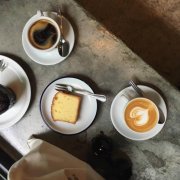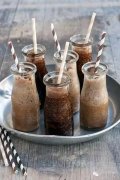Introduction of El Salvador Pacamara coffee beans, description of characteristics and flavor

For professional baristas, please follow the coffee workshop (Wechat official account cafe_style)
Brief introduction
In February 2014, Blumas-Pacamara and Bourbon species, the champion manor of sa.
Ernesto é ndez is the only legendary coffee figure who won two championships in the history of the Superior Cup Coffee Competition in Saguota. he won the championship with Dream and Brumas respectively. What is on the shelves today is the champion production batch of Brumas!
Ernesto, we nicknamed him Nate Neto, had an in-depth discussion with fans and roommates on the second floor of the Osher Taichung store, sharing the secret of coffee growing and the secret of winning excellent cups. During the meeting, he used Las Brumas beans. The following photo was taken from Neto's in-depth discussion in Osher:
He was the third generation of coffee growers in his family. He was deeply influenced by his family. He rolled in the coffee garden from an early age and didn't take over the coffee garden until after his father died in 1995. At the seminar, Neto told everyone that he did not like coffee at that time and was forced by the situation to take over the work of running and managing the coffee garden. After graduating from university, he went to work in two coffee processing farms (J. Hill and Cia., S.A de CV and JASAL, S.A de CV) and two companies let him come into contact with the quality identification method-cup test for the first time. In the first blind test, the boss was surprised that he could distinguish between defective beans and low-quality commercial beans. In 2003, in the CoE domestic cup test evaluation, he won the first honor, and from then on, he used the cup test to identify the quality. Improving planting and treatment has become an important task for Nate.
Neto won a total of five cup winners, including two championships, in the history of coffee in Sacramento, is an amazing achievement, today's Blumas Manor, that is, the 2012 Excellence Cup champion, Nesto hand-picked the winning block, which produces varieties including Pacamara and bourbon species, and he selects excellent batches directly to Osher, which is directly related to Osher coffee.
Las Brumas, Brumas, means "often surrounded by fog". The literal translation of Brumas Manor should be "Fog Manor". Here is the intersection of the three volcanic mountains, the climate is quite different from the Neverland Manor on the other side of the Santa Ana volcano, and the coffee flavor is also unique. Las Brumas is about 45 minutes' drive from Santa Ana City. My first trip to Brumas was from Santa Ana at about 01:30 in the afternoon. I arrived at the entrance of the manor at about two o'clock. Brumas starts at 1450 meters above sea level, and as the path becomes steeper and steeper, it also climbs to about 1750 meters above sea level. On it, there is a primeval forest up to 2000 meters high. The scenery is very beautiful.
Las Brumas's soil nutrients come from the eruption ash of Ilamatepec volcanoes, which forms excellent volcanic fertile soil, while the unique microclimate and continuous fog clouds formed by the three volcanoes Santa Ana, Cerro Verde and Izalco inspired my name Brumas, which is actually the actual situation of the manor site.
This batch of Osher is directly related to the bourbon and Pacamara species planted in the champion block of Brunas Manor more than 1700 meters. Nate talked about his coffee planting view, constantly stressed that carefully picking 100% ripe cherries is an important task, he is responsible for telling the harvester when they can be planted, then carefully manage the details after making, and keep the sample cup for testing in each batch, early in 2012. The Pacamara batch at the top of Blumas Manor was hit by a strong wind for three days. He lost 90 per cent of his coffee fruit and stayed at home crying for 10 days. Ten days later, he cheered up, looked back, comforted the old employees who had been with him for many years, cheered up, carefully dealt with the undamaged coffee fruit, singled out the best batch to compete again, and won the 2012 CoE championship! When Neto slowly talked about this process at the forum yesterday, everyone was moved.
Asked why he was able to win the championship twice, he modestly said: microclimate, altitude, soil, careful planting and cup quality control are necessary elements, careful appreciation of his coffee over the years, excellent planting environment, careful care, careful selection of coffee cherries, picky post-harvest homework and other conditions, the following is the appearance of the batch selected by Neto for Osher:
Introduction to Pacamara varieties: Pacamara Coffee is a hybrid between Pacas Pacas (sudden mutation) and giant bean Maragogype (elephant bean) found in El Salvador in the 1950s. It was first cultivated by Salvadoran researchers in 1958. Pacamara is a rare artificial breeding of both excellent varieties, green from the blue but better than the blue, perfectly inheriting the advantages of the mother plant, both excellent taste of the Pacas species, raw bean granules also inherit the large size of Maragogipe, the bean body is at least 70%, 80%, more than 17 orders, 100%, 18 eyes, 90%. Average bean length 1.03 cm (general bean about 0.8-0.85 cm) average bean width 0.71 cm (general bean about 0.6-0.65), thickness 0.37 cm, bean shape plump and round. The biggest feature of this variety is that it is sour, lively and tricky, sometimes with biscuits and sometimes fruity, with excellent thickness and greasy feeling. It is of the best quality from El Salvador and Guatemala.
[manor introduction]: Finca Ataisi Manor is located in the volcanic producing area of Izalco (Izakou) region, Sonsonate Province, El Salvador. Because the soil of the manor is very rich in organic matter, the average elevation of the manor is about 1800 meters and the terrain is steep. It is one of the highest local manors. At present, the owner of the manor is managed by Mr. Rene Martin, the owner of the manor. Mr. Rene Martin's idea is to maintain the original traditional planting methods in El Salvador as far as possible, to maintain a large range of natural agroforestry ecology in the garden except for pruning and irrigation, and more than 90% of the manors are planted with Pacamara varieties.
In addition to excellent planting, Finca Ataisi Manor also has its own coffee washing facilities, which can not only avoid price exploitation by outsiders, but also be more rigorous and carefully selected.
Country: El Salvador
Name of the manor: Las Brumas
Producer: Ernesto Menendez
Town: Sonsonate
Production area: Apaneca-Ilamatepec
Marked: Orsir Direct Trade
Harvest season: April 2013
Treatment: traditional washing
Variety: Pacamara and bourbon
Coffee production scale: 60 mu
Altitude: 1700 m
Cup test report: Mo+ baking degree
Dry fragrance: Apple, honey, sweet spices, flowers, berries, lemon wasp grass
Wet fragrance: honey, sweet fruits, cherries, flowers, berries, maple syrup
Sipping: clean, sweet, sweet cherries, cranberries, cream chocolate, citrus, hazelnuts, sweet spices and delicate juices.
Everyone's taste is not necessarily what they like.
You can consider buying a small amount and trying different baking degrees.
Soy beans in an explosion
Drop the beans at the end of the explosion.
Drop the beans from the end of the first explosion to the second explosion.
Touch the beans under the second explosion.
Put the beans into the second explosion for 10-15 seconds
The second explosion of dense beans
I hope you bakers can find a more favorite flavor.
Many friends do not know about El Salvador, which is located in Central America, bordered by Guatemala and Honduras in the north, and the Pacific coastline in the west and south. El Salvador is the smallest country in Central America and the most densely populated country in Central America. Topography to mountains, plateaus-based, multi-volcanic, Santa Ana active volcano 2385 meters above sea level, the highest peak in the country; the north for the Lompa River Valley; the south for the narrow coastal plain.
Although the land area of El Salvador is small, it has dozens of volcanoes, and it is the country with the highest volcanic density in the world, so it is called the "country of volcanoes". The average elevation of the whole country is high, and the geographical environment is very favorable for coffee growth, and the western part of El Salvador is the main coffee producing area near Guatemala.
Climate characteristics, savanna climate. The plain area belongs to the tropical rain forest climate and the mountain area belongs to the subtropical forest climate. The average annual temperature is 25-28 ℃. The annual precipitation is more than 1800 mm in mountain areas and about 1000 mm in coastal areas. The rainy season is from May to October.
Don't underestimate El Salvador's coffee production. In its heyday, it was once the fourth largest coffee producer in the world, but after decades of civil war, it almost dragged down the coffee industry. fortunately, the war has stopped in recent years, and the coffee industry has come back to life. The only advantage that the civil war brought to the Salvadoran country is that the farmers left their fields barren and failed to catch up with the most popular Katimo sun-exposed cultivation trains in the past two decades, thus preserving the ancient bourbon and Tibika varieties, that is to say, El Salvador still uses the most traditional shade planting methods.
It has a positive effect on the aroma of coffee. In 2005, the Salvadoran mixed-race variety coe showed off, which confused many international cup testers. They didn't expect that this hybrid bean not only broke the boundary of coffee, but also expanded the visibility of Salvadoran coffee.
El Salvador boutique coffee is concentrated in the volcanic rock producing areas of both Santa Ana in the west and Charantanan fruit in the northwest. In the past few years, the top 10 in cup tests almost all came from the two producing areas, with an elevation of about 9-1500 meters, mainly bourbon (68%), and Pacas (29%). Mixed-race Pacamara, Dulaai, and Kaddura accounted for only 3%.
The coffee harvest lasts from November to March. The fresh fruit of coffee is picked by hand. Coffee is grown mostly by small farmers in El Salvador, and farmers use traditional cultivation methods: almost 100% shade cultivation. The coffee harvest lasts from November to March. The fresh fruit of coffee is picked by hand.
Generally speaking, Salvadoran coffee inherits the mild quality of Sino-American coffee, which is soft, slightly sour and sweet. At the same time, it also has its own characteristics: the aroma is slightly sour and very soft; it is pure and has no miscellaneous flavor, and the taste balance is excellent; it is as smooth as cream chocolate and impressive; the dense feeling in the mouth of the coffee gives the coffee a deep taste and a long aftertaste.
Important Notice :
前街咖啡 FrontStreet Coffee has moved to new addredd:
FrontStreet Coffee Address: 315,Donghua East Road,GuangZhou
Tel:020 38364473
- Prev

El Salvador Pacamara Coffee Bean introduction Variety characteristics Variety Manor Information
For professional baristas, please follow the coffee workshop (Wechat official account cafe_style) Pacamara variety profile: Pacamara coffee was discovered in El Salvador in the 1950s as a hybrid between Pacas Pacas (a sudden mutation) and giant bean Maragogype (elephant bean). It was first cultivated by Salvadoran researchers in 1958. The species of Pacamara is rare and artificial.
- Next

Guatemala Pacamara Coffee Estate Introduction Producing Area Flavor Description Features
Professional barista exchanges, please pay attention to coffee workshop (Weixin Official Accounts cafe_style )[Manor Introduction]: Finca Ataisi Manor is located in the volcanic producing area of Izalco (Izaco) area in Sonsonate Province of El Salvador. Due to the volcano, the soil of the manor is very rich in organic matter. The average altitude of the manor is about 1,800 meters and the terrain is steep, which is the highest altitude in the local area.
Related
- Detailed explanation of Jadeite planting Land in Panamanian Jadeite Manor introduction to the grading system of Jadeite competitive bidding, Red bid, Green bid and Rose Summer
- Story of Coffee planting in Brenka region of Costa Rica Stonehenge Manor anaerobic heavy honey treatment of flavor mouth
- What's on the barrel of Blue Mountain Coffee beans?
- Can American coffee also pull flowers? How to use hot American style to pull out a good-looking pattern?
- Can you make a cold extract with coffee beans? What is the right proportion for cold-extracted coffee formula?
- Indonesian PWN Gold Mandrine Coffee Origin Features Flavor How to Chong? Mandolin coffee is American.
- A brief introduction to the flavor characteristics of Brazilian yellow bourbon coffee beans
- What is the effect of different water quality on the flavor of cold-extracted coffee? What kind of water is best for brewing coffee?
- Why do you think of Rose Summer whenever you mention Panamanian coffee?
- Introduction to the characteristics of authentic blue mountain coffee bean producing areas? What is the CIB Coffee Authority in Jamaica?

